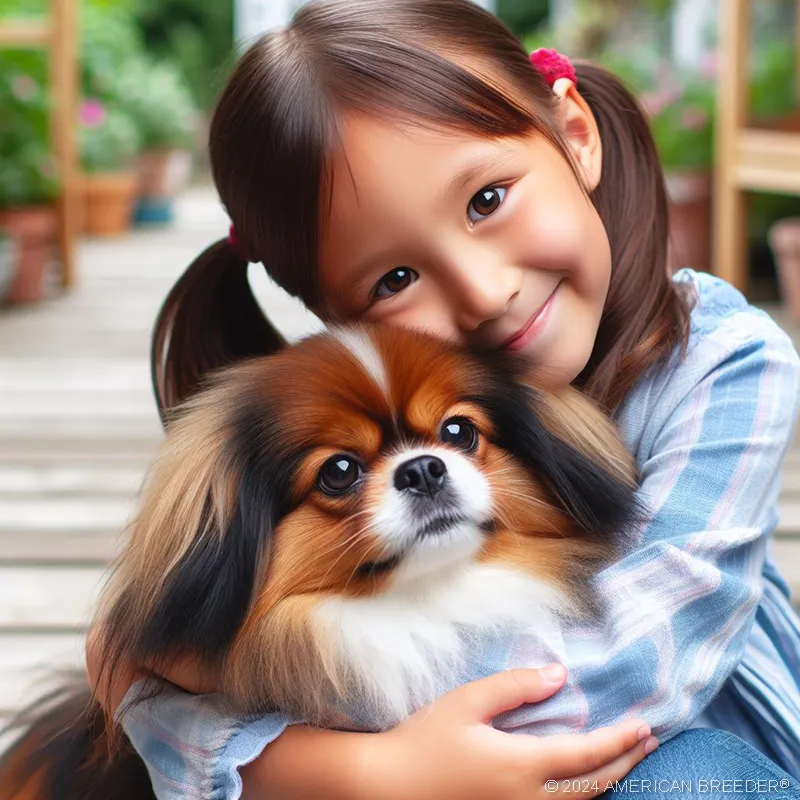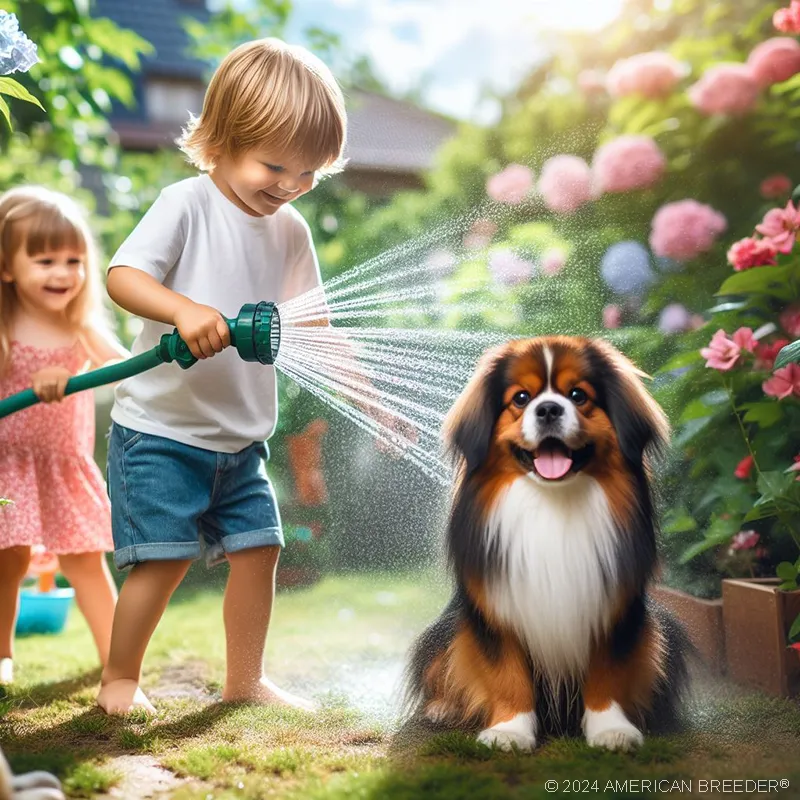Playful Adventures with Tibetan Spaniels
Introduction to Tibetan Spaniel Dogs
Unraveling the Mystique of Tibetan Spaniel Dogs
 Welcome to the enchanting world of Tibetan Spaniel dogs, a breed that is as captivating as it is unique. These dogs hail from the mystical land of Tibet, where they once graced the monasteries as loyal companions and vigilant sentinels. As we embark on this journey to unravel the secrets of Tibetan Spaniels, we'll explore their rich history, distinctive physical characteristics, and the variations that make each one a one-of-a-kind companion.
Welcome to the enchanting world of Tibetan Spaniel dogs, a breed that is as captivating as it is unique. These dogs hail from the mystical land of Tibet, where they once graced the monasteries as loyal companions and vigilant sentinels. As we embark on this journey to unravel the secrets of Tibetan Spaniels, we'll explore their rich history, distinctive physical characteristics, and the variations that make each one a one-of-a-kind companion.
A Glimpse into History
The Tibetan Spaniel's history is interwoven with the spiritual and cultural tapestry of Tibet. Monasteries in the remote Himalayas held these dogs in high esteem, where they played an essential role in the daily lives of monks. They served as watchdogs, using their keen senses and sharp barks to alert the monasteries to approaching danger. This deep-rooted history is a testament to the breed's loyalty and protective instincts.
Tibetan Spaniel's Physical Charms
Tibetan Spaniels are a small breed, standing at around 10 inches in height and weighing between 9 to 15 pounds. Their most distinctive feature is their slightly pushed-in face, adorned with expressive dark eyes that seem to convey wisdom beyond their years. They sport a flowing mane of fur, often compared to a lion's, and a plumed tail that gracefully arches over their back. Their double coat can come in various colors and patterns, adding to their visual appeal.
Variations Within the Breed
While there are breed standards for Tibetan Spaniels, there can be delightful variations in coat color, markings, and size. These differences make each Tibetan Spaniel a unique individual, adding to the charm of the breed. Understanding these variations will help you appreciate the diversity that exists within this breed.
Purpose and Original Use
 Originally bred as companions for Tibetan monks, these dogs excel at providing emotional support and companionship. Their watchful nature and alertness, developed over centuries of guarding monasteries, make them excellent family pets. Today, Tibetan Spaniels may no longer stand guard at Tibetan monasteries, but their loyalty and protective instincts remain intact, making them wonderful additions to households around the world.
Originally bred as companions for Tibetan monks, these dogs excel at providing emotional support and companionship. Their watchful nature and alertness, developed over centuries of guarding monasteries, make them excellent family pets. Today, Tibetan Spaniels may no longer stand guard at Tibetan monasteries, but their loyalty and protective instincts remain intact, making them wonderful additions to households around the world.
In this chapter, we've uncovered the historical roots and physical allure of Tibetan Spaniel dogs. As we continue our exploration, we'll delve deeper into their temperament, behavior, and the essentials of their care, ensuring that you have a comprehensive guide to this captivating breed.
Understanding Tibetan Spaniel Temperament
Unmasking the Complex Yet Endearing Personality of Tibetan Spaniels
In the heart of every Tibetan Spaniel lies a personality that's as intriguing as it is delightful. These dogs are known for their unique blend of characteristics, from their independent spirit to their unwavering loyalty. In this chapter, we'll delve into the inner workings of Tibetan Spaniel temperament, helping you understand what makes them such exceptional companions.
Independent Thinkers
Tibetan Spaniels are renowned for their independent nature. Unlike some breeds that constantly seek attention, these dogs are content with their own company and don't always demand your undivided focus. This trait can be traced back to their history as monastery dogs, where they needed to be self-reliant to a certain extent. However, this independence doesn't mean they're distant; in fact, they form deep bonds with their families.
Loyal to the Core
 Once a Tibetan Spaniel considers you part of their pack, their loyalty knows no bounds. They'll stand by your side through thick and thin, providing unwavering support and companionship. Their protective instincts, honed over centuries as monastery watchdogs, make them excellent guardians of their loved ones. While they might not be the most aggressive in defending their territory, their vigilant barks will alert you to any potential intruders.
Once a Tibetan Spaniel considers you part of their pack, their loyalty knows no bounds. They'll stand by your side through thick and thin, providing unwavering support and companionship. Their protective instincts, honed over centuries as monastery watchdogs, make them excellent guardians of their loved ones. While they might not be the most aggressive in defending their territory, their vigilant barks will alert you to any potential intruders.
Playful and Spirited
Beneath that regal exterior, Tibetan Spaniels are playful souls. They retain their puppy-like exuberance well into adulthood, making them a joy to be around. They enjoy games, fetch, and interactive toys, and their mischievous streak can bring laughter to your home. This playful spirit is an endearing quality that makes them a favorite among families.
Intelligence and Trainability
Tibetan Spaniels are intelligent dogs, which can sometimes translate into a touch of stubbornness. They'll quickly grasp what's expected of them but may choose when and how they comply. Training should be positive, consistent, and patient, focusing on rewards and praise. Socialization from an early age is essential to ensure they grow into well-rounded adults.
Potential Challenges
While Tibetan Spaniels have many admirable traits, they are not without their challenges. Their independent nature can sometimes lead to a bit of stubbornness, which may require creative training approaches. Additionally, their strong protective instincts can result in barking if not properly managed. Understanding these aspects of their temperament will help you navigate life with a Tibetan Spaniel more smoothly.
In this chapter, we've explored the multifaceted temperament of Tibetan Spaniels. Their independence, loyalty, playfulness, and intelligence make them fascinating companions. However, it's essential to understand their unique traits fully to ensure a harmonious relationship. As we move forward, we'll delve into their care requirements, including grooming, nutrition, and health considerations.
Caring for Your Tibetan Spaniel
Meeting the Unique Needs of Your Beloved Companion
Now that we've uncovered the fascinating world of Tibetan Spaniel temperament, it's time to delve into the practical aspects of caring for your furry friend. In this chapter, we'll guide you through essential aspects of Tibetan Spaniel care, from grooming routines to nutritional requirements and healthcare considerations.
Tibetan Spaniels boast a lush double coat that can vary in length. While these coats are undeniably beautiful, they do require regular maintenance. Brushing your Tibetan Spaniel several times a week helps prevent matting and keeps their coat healthy. Pay special attention to the feathering on their ears, legs, and tail, as these areas are prone to tangles.
Regular baths are also necessary, usually every one to two months, depending on their activity level and outdoor adventures. Use a gentle dog shampoo to maintain their skin's health. Additionally, check their ears for any signs of infection and clean them as needed. Keeping their teeth clean with regular brushing is essential for their overall health.
Nutritional Needs
A balanced diet is crucial for the health and well-being of your Tibetan Spaniel. Ensure you provide high-quality commercial dog food or a well-balanced homemade diet recommended by your veterinarian. Monitor their weight to prevent obesity, a common issue among this breed. Like many small dogs, Tibetan Spaniels can be prone to dental issues, so consider dental chews or a dental care routine.
As with any dog, fresh water should always be available. Keep in mind their portion sizes should align with their age, size, and activity level. Regularly consult with your veterinarian to make sure you're providing the best nutrition for your Tibetan Spaniel's unique needs.
Health Considerations
Tibetan Spaniels are generally healthy dogs with a lifespan of around 12 to 15 years. However, like all breeds, they can be prone to certain health issues. Keep an eye out for common conditions such as hip dysplasia, patellar luxation, and progressive retinal atrophy (PRA). Regular veterinary check-ups and screenings can help catch and address these issues early.
 Allergies are another concern, with skin allergies being relatively common in this breed. Pay attention to any signs of itching, redness, or inflammation and consult your veterinarian for proper management. Maintaining a healthy weight and providing regular exercise can also prevent joint and mobility issues.
Allergies are another concern, with skin allergies being relatively common in this breed. Pay attention to any signs of itching, redness, or inflammation and consult your veterinarian for proper management. Maintaining a healthy weight and providing regular exercise can also prevent joint and mobility issues.
Exercise and Mental Stimulation
Despite their small size, Tibetan Spaniels are active dogs that require regular exercise. Daily walks, playtime, and interactive toys will keep them physically and mentally engaged. They also enjoy puzzle toys that challenge their problem-solving skills.
Socializing and Training Your Tibetan Spaniel
Building Strong Bonds and Polishing Their Manners
In this chapter, we'll explore how Tibetan Spaniels interact with the world around them, from their relationship with children and other pets to their training needs and tips for success. Understanding these aspects is vital to ensure your Tibetan Spaniel is a well-adjusted and well-behaved member of your household.
Socialization with Children and Other Pets
Tibetan Spaniels typically have friendly and affectionate personalities, making them excellent companions for families with children. However, as with any dog, it's crucial to supervise interactions between your Tibetan Spaniel and young children. Teach your children how to approach and handle the dog gently to avoid any accidental rough play.
When it comes to other pets, Tibetan Spaniels usually get along well with other dogs and even cats if properly introduced. Early socialization is essential to teach your dog how to interact appropriately with other animals. Gradual introductions, positive reinforcement, and supervised playtime can help your Tibetan Spaniel build positive relationships with other pets.
Training and Obedience
Tibetan Spaniels are intelligent dogs, but they can also be a bit independent and stubborn at times. Patience and consistency are key when it comes to training this breed. Here are some training tips to help you and your Tibetan Spaniel succeed -
 Start Early - Begin training and socialization as early as possible. Puppies are more receptive to learning and adapting to new experiences.
Start Early - Begin training and socialization as early as possible. Puppies are more receptive to learning and adapting to new experiences.
Positive Reinforcement - Use positive reinforcement techniques such as treats, praise, and toys to reward good behavior. This breed responds well to positive motivation.
Consistency - Establish clear rules and boundaries and be consistent in enforcing them. Tibetan Spaniels thrive in structured environments.
Socialization - Expose your dog to various people, animals, and environments to ensure they grow up to be well-adjusted and confident.
Basic Commands - Teach essential commands like sit, stay, and come. These commands not only ensure their safety but also strengthen your bond.
Exercise Their Minds - Tibetan Spaniels enjoy mental challenges, so incorporate puzzle toys and interactive games into their routine to keep their minds engaged.
Be Patient - Remember that some Tibetan Spaniels may be a bit stubborn. Be patient, and avoid punishment-based methods, as they can be counterproductive.
Exercise Needs
While Tibetan Spaniels are a small breed, they still require daily exercise. Daily walks, playtime in a secure backyard, or indoor games will help burn off their energy and keep them physically fit. Keep in mind that they also appreciate mental stimulation, so puzzle toys and interactive playtime are essential for their well-being.
Practical Considerations for Living with a Tibetan Spaniel
Creating a Comfortable Environment for Your Furry Friend
In this chapter, we'll delve into the practical aspects of sharing your life with a Tibetan Spaniel. We'll discuss their adaptability to different living conditions, climate considerations, and recommendations for their living arrangements.
 Living Arrangements and Adaptability
Living Arrangements and Adaptability
Tibetan Spaniels are adaptable dogs that can thrive in various living conditions. Whether you reside in a spacious home with a backyard or a cozy apartment in the city, this breed can adapt as long as their exercise and mental stimulation needs are met.
House Size - While Tibetan Spaniels are small, they appreciate space to move around. Ensure your living space is adequately sized for them to play and explore comfortably.
Apartments - These dogs are well-suited for apartment living, but regular walks and playtime are essential to keep them happy and healthy.
Backyard - If you have a backyard, make sure it's securely fenced. Tibetan Spaniels can be curious and might try to explore if they see something interesting outside.
Climate Considerations - Tibetan Spaniels have a thick double coat that provides insulation in colder weather. They can tolerate cooler temperatures, but in extreme cold, consider providing them with a doggy sweater or jacket. In hot weather, ensure they have access to shade and fresh water, as their thick coat can make them susceptible to overheating.
Yard Size Recommendations
If you have a yard, it's important to ensure it's suitable for your Tibetan Spaniel. Here are some yard size recommendations -
Small Yard: If you have a small yard, make the most of the space by providing toys and play equipment. Regular playtime and exercise outings are crucial.
 Medium to Large Yard: With a larger yard, your Tibetan Spaniel will have more room to roam. However, supervision is still necessary to prevent them from digging or escaping.
Medium to Large Yard: With a larger yard, your Tibetan Spaniel will have more room to roam. However, supervision is still necessary to prevent them from digging or escaping.
Secure Fencing: Regardless of yard size, secure fencing is essential. Tibetan Spaniels are known for their curiosity, and they might try to dig under or jump over a fence if they're intrigued.
Ideal Living Conditions
The ideal living conditions for a Tibetan Spaniel include -
A Loving Home - Tibetan Spaniels thrive in homes where they receive plenty of attention and affection from their owners.
Regular Exercise - Daily exercise is a must. Whether it's a walk in the park or a play session in the yard, physical activity keeps them happy.
Mental Stimulation - These dogs are intelligent and benefit from puzzles, interactive toys, and mental challenges to prevent boredom.
Grooming Routine - Maintain a regular grooming routine to keep their coat in good condition and minimize shedding.
Proper Nutrition: Provide a balanced diet tailored to their age, size, and activity level.
Training and Obedience for Tibetan Spaniels
The Intelligence and Trainability of Your Tibetan Spaniel
 We will explore the training needs of Tibetan Spaniels, their intelligence, and recommended training approaches to harness their potential.
We will explore the training needs of Tibetan Spaniels, their intelligence, and recommended training approaches to harness their potential.
Trainability and Intelligence
Tibetan Spaniels are known for their intelligence and quick learning. They enjoy mental challenges and thrive when engaged in training activities. However, their independent nature can sometimes make them a bit stubborn.
Independent Thinkers - Tibetan Spaniels are independent dogs, which means they may not always be eager to please. They tend to think for themselves and may choose whether or not to follow a command.
Positive Reinforcement - Positive reinforcement is the most effective training approach for Tibetan Spaniels. Reward-based training, using treats and praise, works wonders to motivate them.
Consistency - Consistency in training is crucial. Set clear boundaries and be patient but firm with your commands.
Socialization - Early socialization is vital to prevent shyness or fearfulness. Expose your Tibetan Spaniel to various people, animals, and environments from a young age.
Basic Commands - Start with basic obedience commands like "sit," "stay," and "come." Once they master these, you can move on to more advanced commands and tricks.
Training Techniques and Skills
When training your Tibetan Spaniel, consider these techniques and skills -
Clicker Training - Clicker training, which pairs a clicking sound with treats, can be highly effective for this breed. They quickly associate the click with a reward.
Leash Training - Due to their independent nature, leash training is essential. Teach them to walk on a leash without pulling.
Crate Training - Crate training can help with housebreaking and providing a safe space for your dog.
Housetraining - Be patient with housetraining, and use positive reinforcement when they eliminate outdoors.
Basic Manners - Teaching basic manners like not jumping on people or barking excessively is essential for a well-behaved Tibetan Spaniel.
While Tibetan Spaniels are intelligent, training them can present some challenges -
Stubbornness- Their independent streak can lead to stubborn behavior. Patience and consistency are key.
Barking - They tend to be alert and may bark at perceived threats. Training them to stop barking on command can be helpful.
Separation Anxiety - This breed is prone to separation anxiety. Gradual departures and arrivals can help ease their anxiety.
Socialization - If not properly socialized, Tibetan Spaniels can become shy or wary of strangers. Early socialization is crucial.
Digging - Some may have a tendency to dig. Providing a designated digging area can redirect this behavior.
Exercise Needs for Tibetan Spaniels
Keeping Your Tibetan Spaniel Active and Healthy
Exercise Requirements
Tibetan Spaniels are a small breed, but they are moderately active and enjoy regular exercise. Meeting their exercise needs is essential to keep them healthy and happy.
Daily Activity - These dogs benefit from at least 30 minutes to an hour of exercise each day. This can be a combination of walks, playtime, and mental stimulation.
Playful Nature- Tibetan Spaniels have a playful disposition and enjoy interactive play with their owners. Toys like puzzle feeders and interactive games can provide mental exercise.
Social Interaction - They are social dogs and enjoy playdates with other dogs. Socializing with other dogs not only provides physical exercise but also mental stimulation.
Chasing Games - Tibetan Spaniels love to chase toys or balls. Playing fetch in a safe, enclosed area can be an excellent way to burn off energy.
In addition to physical exercise, mental stimulation is crucial for this breed's well-being -
Puzzle Toys - Puzzle toys that dispense treats can keep their minds engaged as they figure out how to get the rewards.
Obedience Training - Regular training sessions, even if just for a few minutes each day, can challenge their minds and reinforce commands.
New Environments - Take them on walks in different environments to expose them to new sights and smells.
Exercise Challenges
Despite their moderate exercise needs, Tibetan Spaniels do present some challenges -
Weather Sensitivity - They are sensitive to extreme temperatures, so exercise should be adjusted accordingly in very hot or cold weather.
Walking on Leash - Some Tibetan Spaniels can be stubborn on the leash, so leash training is essential for enjoyable walks.
Separation Anxiety - If left alone for long periods, they may become anxious. Sufficient exercise and mental stimulation can help alleviate this.
Financial Considerations for Tibetan Spaniels
Understanding the Costs of Caring for Your Tibetan Spaniel
In this chapter, we will explore the financial aspects of owning a Tibetan Spaniel, including potential costs and budgeting tips to ensure their well-being without breaking the bank.
Initial Costs
When you decide to bring a Tibetan Spaniel into your home, there are several initial costs to consider
Adoption or Purchase Fee - The cost of acquiring a Tibetan Spaniel can vary significantly depending on whether you adopt from a rescue or purchase from a breeder. Adoption fees are generally lower, while purebred puppies from reputable breeders can be more expensive.
Vaccinations and Microchipping - Your new puppy will need vaccinations and a microchip for identification. These initial vet visits can add to your initial expenses.
Supplies: You'll need to invest in supplies like food and water bowls, a leash and collar, a bed, toys, and grooming tools.
Ongoing Expenses
Owning a Tibetan Spaniel also comes with ongoing expenses -
Food - High-quality dog food is essential for their health. The cost of dog food can vary based on the brand and quality.
Veterinary Care - Regular check-ups, vaccinations, and preventive medications are necessary for your dog's health. It's wise to budget for unexpected medical expenses as well.
Grooming - Tibetan Spaniels have a double coat that requires regular brushing. If you don't do the grooming yourself, you'll need to budget for professional grooming sessions.
Training and Socialization - Enrolling your dog in obedience classes or hiring a trainer may be necessary, especially if you're a first-time dog owner.
Budgeting Tips
To ensure you can comfortably provide for your Tibetan Spaniel, consider the following budgeting tips -
Emergency Fund - Set aside an emergency fund for unexpected vet bills. This can help alleviate the financial stress of a sudden illness or injury.
Pet Insurance - Consider investing in pet insurance to help cover veterinary expenses. Shop around for policies that suit your budget and provide adequate coverage.
Regular Maintenance - Invest in regular grooming and preventive care to avoid more significant health issues down the road.
DIY Training - While professional training can be beneficial, there are many resources available for DIY training and socialization, which can save you money.
Conclusion
As a Tibetan Spaniel owner, you have access to a wide range of resources and support to ensure your dog's happiness and well-being. From breed clubs to online communities, there's a network of fellow enthusiasts ready to help and share their knowledge. Remember that owning a dog is a lifelong commitment, and by staying informed and connected, you'll provide the best possible life for your beloved Tibetan Spaniel. The Tibetan Spaniel is a remarkable breed with a long history of companionship and loyalty. Its distinctive appearance, intelligent nature, and affectionate personality make it a delightful addition to any family. However, it's important to remember that owning a dog is a long-term commitment that requires time, effort, and resources. By providing your Tibetan Spaniel with proper care, training, and socialization, you can enjoy a rewarding and loving relationship that lasts a lifetime.
We hope this guide has been a valuable resource for both new and experienced Tibetan Spaniel owners. Remember that every dog is unique, and while breed traits provide a general guideline, individual personalities may vary. Be patient, loving, and attentive to your Tibetan Spaniel's needs, and you'll create a bond that brings joy and fulfillment to your life. As you embark on this journey with your Tibetan Spaniel, may it be filled with wagging tails, joyful barks, and countless cherished moments. Thank you for choosing the Tibetan Spaniel as your canine companion, and we wish you many happy years together.
If you have any further questions or need additional information, don't hesitate to reach out to breed clubs, veterinarians, or online communities dedicated to Tibetan Spaniels. The world of dog ownership is a vast and supportive one, and there are always resources available to assist you on your adventure with your beloved Tibetan Spaniel. Once again, congratulations on being a proud Tibetan Spaniel owner, and may your bond with your furry friend continue to grow stronger with each passing day. Enjoy the journey of canine companionship to the fullest!
Tibetan Spaniel Dog Quick Reference Guide
Breed Background: Origin: Tibet | Breed Purpose: Companion | AKC Class: Non-Sporting | Year Recognized by AKC: 1984
 Appearance: Size: Small | Weight: 9-15 pounds | Coat Type: Silky double coat | Colors & Patterns: Various colors, often with white markings | Distinctive Features: Expressive eyes, plumed tail, slightly pushed-in face
Appearance: Size: Small | Weight: 9-15 pounds | Coat Type: Silky double coat | Colors & Patterns: Various colors, often with white markings | Distinctive Features: Expressive eyes, plumed tail, slightly pushed-in face
Temperament: Energy Level: 3/5 | Loyalty: 5/5 | Friendliness to Pets: 4/5 | Friendliness to Strangers: 3/5 | Trainability: 4/5 | Playfulness: 4/5 | Frequent Barker: 2/5 | Chase Instincts: 2/5 | Sense of Smell: 3/5 | Drive to Hunt: 2/5
Health & Care: Health Issues: Patellar Luxation, Progressive Retinal Atrophy | Lifespan: 12-15 years | Grooming Difficulty: Moderate | Exercise Needs: Moderate
Socialization: Interaction with Children: Good with supervised children | Interaction with Pets: Generally good with other pets | Interaction with Strangers: Cautious but friendly | Elderly Compatibility: Excellent companion for seniors | Ease of Training: Moderately easy to train
Suitable Living Arrangements: Apartment: Yes | House: Yes | Rural Area: Yes | Yard Size Requirements: Small yard or daily walks
Training & Obedience: Trainability: 4/5 | Intelligence: 4/5 | Obedience: 3/5 | Problem-Solving: 3/5 | Easily Stimulated: 3/5 | Focus Level: 3/5 | Easily Distracted: 2/5
Financial Planning: Typical Price Range: $1,500 - $3,000 | Initial Expenses: Vaccinations, microchipping, spaying/neutering | Ongoing Annual Expenses: Food, grooming, veterinary care
Breeding: Reproductive Maturity: 8-12 months | Litter Frequency: Once a year | Litter Size: 2-4 puppies | Stud Cost: $800 - $1,500 | Breeding Challenges: Small litter size, potential health issues
Did You Enjoy this Article? Share it and Help Us Spread the Word!
If you found this article helpful, we'd appreciate it if you could share it with your friends or link to it from your website, blog, or group! You can also use the convenient social share tabs on the left side of the screen to instantly share this page to your social media feed. For more ways to support and promote the American Breeder Community, visit our Share & Promote Together page for social media posts and memes you can copy and share. Your support means the world to us!
Disclaimer: The information provided in this article is for general informational purposes only and does not constitute legal, medical, financial, or professional advice. While we strive for accuracy, we make no representations or warranties regarding the completeness, accuracy, reliability, or suitability of the information. Please consult with a professional before making decisions based on the content provided. American Breeder Inc. assumes no responsibility for any errors or omissions or for the results obtained from the use of this information.




 AI Support
AI Support